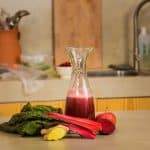Vegetarianism and iron deficiency are two concepts that often go hand in hand. Where meat and fish are hailed as prime sources of iron, those who abstain from these food groups may find it difficult to maintain adequate iron levels. Yet, it doesn’t have to be this way. Crafting a nutrient-dense vegetarian meal plan that caters to iron-deficient individuals is entirely feasible and easier than you might think. This guide will show you how.
Understanding the Importance of Iron
First things first, let’s talk about why iron is such an essential nutrient in the first place. Iron is a mineral our bodies need for a multitude of functions. From helping to create the proteins hemoglobin and myoglobin that carry oxygen in our blood and muscles, to aiding in the production of certain hormones, iron plays a crucial role in our overall health.
A lire aussi : Can Interactive Museum Exhibits Promote Health Education Among Teens?
Individuals who follow a vegetarian or vegan lifestyle might face challenges in getting enough iron from their diet. Iron found in plant-based foods, referred to as non-heme iron, is less easily absorbed by the body compared to heme iron, which is derived from animal products.
However, do not lose heart. With careful meal planning, it is possible for vegetarians to meet their iron needs from plant-based sources.
Lire également : What Role Does Virtual Reality Play in Enhancing Neurorehabilitation for Stroke Survivors?
Identifying Iron-Rich Vegetarian Foods
As you embark on the process of crafting a nutrient-dense vegetarian meal plan, the starting point is to identify which vegetarian foods are rich in iron.
Lentils, beans, chickpeas, tofu, cashews, chia seeds, ground linseed, hemp seeds, pumpkin seeds, kale, dried apricots, figs, raisins, quinoa, and fortified cereals are all excellent sources of iron. These foods can form the basis of your meals, ensuring that you are getting a good dose of iron in your diet each day.
Remember, iron isn’t the only factor to consider here. The body’s ability to absorb iron is influenced by the presence of other nutrients, notably vitamin C. Incorporating vitamin C-rich foods like strawberries, oranges, peppers, and leafy green vegetables into your meals can further aid in iron absorption.
Creating Balanced Meals: Protein, Fiber, and More
Once you have your list of iron-rich vegetarian foods, the next step is creating balanced meals. Just because you’re focusing on iron doesn’t mean you should forget about other nutrients. Balance is key in any diet!
Protein is a vital nutrient that helps to repair body tissues and supports immune function. Luckily, many iron-rich vegetarian foods are also high in protein. Lentils, chickpeas, and tofu are terrific examples.
Fiber, another essential nutrient, aids digestion and can help to stave off hunger between meals. Whole grains like brown rice, whole wheat bread, and quinoa not only contribute to your iron intake but also provide a satisfying dose of dietary fiber.
Don’t forget about healthy fats! Avocado, chia seeds, flaxseeds, and nuts are great plant-based sources of these essential nutrients.
Sample Vegetarian Meal Plan for Iron-Deficient Individuals
Now that you’ve got a better idea of the types of foods to include, let’s delve into an example meal plan tailored for iron-deficient individuals.
Breakfast: Start your day with a bowl of iron-fortified cereal topped with a generous sprinkle of chia seeds, a handful of raisins, and a splash of almond milk. Pair your cereal with a glass of freshly squeezed orange juice to boost your vitamin C intake and enhance iron absorption.
Lunch: For lunch, enjoy a hearty lentil and vegetable soup. Lentils offer a substantial amount of iron, and the accompanying vegetables will provide additional iron and vitamin C.
Snack: Snack on roasted chickpeas or a handful of cashews. These nutrient-dense options will tide you over until dinner time while also contributing to your daily iron quota.
Dinner: For dinner, create a colorful stir-fry with tofu, bell peppers, and kale, served over a bed of quinoa. This meal covers all your bases with iron, protein, fiber, and vitamin C.
A Word on Iron Supplements
Although it’s entirely possible to meet your iron needs through diet, some individuals may still struggle to maintain adequate levels. In such cases, an iron supplement might be necessary. Always consult with a healthcare provider before starting any new supplement regimen. They can provide guidance based on your individual needs and monitor your iron levels to ensure they are within a healthy range.
Crafting a nutrient-dense vegetarian meal plan for iron-deficient individuals may require a bit of creativity and planning, but it’s far from impossible. By incorporating a variety of iron-rich foods and ensuring balanced nutrition, you can thrive on a vegetarian diet without compromising on your iron intake.
Iron and Cooking Methods: Maximizing Iron Absorption
You’ve now learned about the types of foods that are rich in iron and how to create balanced meals. But did you know that the way you cook your food can also impact the iron content? Yes, you read it right. Certain cooking methods can enhance the bioavailability of iron in food and, subsequently, its absorption in the body.
Steaming and boiling are two methods that tend to preserve the maximum amount of iron in vegetables. When steaming, it’s important not to overcook the vegetables as this can lead to a loss of nutrients. Boiling is another good choice, but be aware that some of the iron may leach into the water. If you’re making a soup or stew, this isn’t a problem as you’ll be consuming the liquid as well.
Sautéing or stir-frying your vegetables in a pan with a small amount of oil can also be beneficial. Why? Because the healthy fats in the oil can enhance the absorption of iron. Remember, though, to use oil sparingly as it’s high in calories.
Another trick is to cook in cast iron pots and pans. Acidic foods like tomatoes and citrus can leach iron from the pan, increasing the iron content of your meal. This can be especially helpful for those who are struggling to meet their iron needs through diet alone.
Lastly, remember to pair iron-rich foods with foods high in vitamin C to enhance iron absorption.
Conclusion: Embrace a Nutrient-Dense Vegetarian Lifestyle
In conclusion, it’s completely attainable to maintain a nutrient-dense vegetarian meal plan even if you are iron-deficient. It just takes a little understanding about the importance of iron, identifying iron-rich foods, creating balanced meals, and using cooking methods that enhance iron absorption.
Remember, the key is balance. There’s no need to obsess over getting enough iron at every meal. Instead, aim for a diverse diet that includes a wide variety of iron-rich foods throughout the day. And don’t forget about other essential nutrients like protein, fiber, and healthy fats.
Lastly, keep in mind that every individual’s needs are different, and what works for one might not work for another. It’s always best to consult with a healthcare provider or registered dietitian to ensure you’re meeting all your nutritional needs, especially when dealing with a condition like iron deficiency. They can assess your diet, suggest modifications if necessary, and possibly recommend supplements if required.
By adopting these guidelines, you can enjoy a healthy, nutrient-dense vegetarian lifestyle while effectively managing your iron levels. Happy eating!











